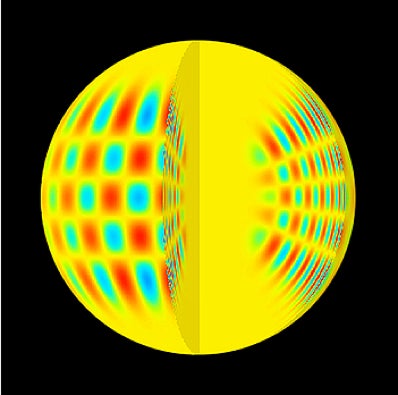Some of the oldest sounds in the galaxy resonate within the stars of M4, one of the oldest globular clusters in our galaxy.
In a paper published in the Monthly Notices of the Royal Astronomical Society (MNRAS), researchers from the University of Birmingham’s School of Physics and Astronomy have determined the age and mass of these stars by detecting their resonant acoustic oscillations.
“We are able for the first time to detect these global oscillations modes in stars that belong to a globular cluster,” says Dr. Andrea Miglio, leader of the study from the University of Birmingham’s School of Physics and Astronomy. “We can finally get a handle on the astero-seismic age scale for very old stars, which was missing before this study.”
The researchers used NASA’s Kepler/K2 data to study these resonant oscillations of the stars using a technique called asteroseismology. This is when oscillations are caused by “sound” (vibrations in gas) trapped inside the stars due to convection and cause tiny pulses in brightness of the star that Kepler can detect. Asteroseismology is currently the only technique that can precisely date these older stars in globular clusters.
“So with K2, we could monitor the same stars for about 80 days; this is about what is really necessary to be able to reliably detect these oscillation modes, which are very tiny perturbations of the stellar brightness,” says Miglio. “K2 and Kepler are the only instruments, or telescope, which can deliver this kind of data.”
The sound trapped inside these stars is the key for using asteroseismology as this is what creates the pulses in light. Convection produces the acoustic noise that supplies the energy for these global resonant modes, says Miglio. These waves propagate throughout the stellar interior as standing waves, which occur when two waves traveling in opposite directions interfere and form a new wave pattern looking as it is not moving but standing still.
Dr. Miglio and his team can then measure the frequency of this standing wave to learn how big the propagation cavity of the star and the “stratification of the sound speed inside the star” to infer its mass and age says Miglio.
These findings open a door to the secrets to the very early history of our galaxy and how it was formed. Asteroseismology can provide a precise way to determine the mass and age of the oldest stars in the galaxy on a star-to-star basis says Miglio. As there exist thousands of stars that can now be dated thanks to this technique, these stars can now start to answer questions about galactic formation and their spread throughout the halo of our galaxy.
“That tells us about when the Milky Way was assembled in the first place,” says Miglio. “So that’s where we are going.”










